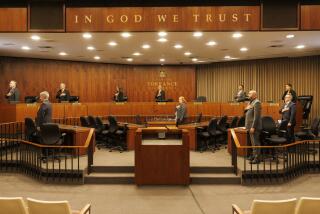Moorpark Wants to Tie Growth to Traffic
Moorpark city officials are readying an ordinance for the November ballot that would count cars, not people, in a plan to tie development to traffic.
The proposed ordinance would limit Moorpark’s General Plan, a blueprint on development, to a maximum amount of traffic in future years. That traffic cap has not yet been determined.
In a move that would allow more voter control over planning, the proposal would trigger an election whenever new development involves zoning changes that push traffic volumes over the allowable limit.
While supporters hail the proposal as an answer to gridlock, its critics say it could become another layer of growth control. The city already has a residential growth-control ordinance that limits the number of building permits issued to 270 a year.
Longstanding complaints about overloaded streets have forced officials in Moorpark, a city of about 26,000, to think about the amount of traffic the city can bear, Councilman Clint Harper said.
During the last six years, Moorpark’s population has tripled and its roads have become jammed with commuters and trucks passing through the area, Harper said.
At rush hour, motorists encounter gridlock on two-lane roads linking Moorpark to Simi Valley and Thousand Oaks, he added.
Traffic “directly affects anyone who commutes in the city,” Harper said. He vowed to launch a petition drive to place the measure on the ballot if council members reject the ordinance when it is reviewed by the City Council in May.
Harper said the ordinance would allow voters to control planning decisions that affect their lives. Currently, developers can bypass voters by requesting a General Plan amendment through the City Council, he said.
The ordinance would be triggered by zoning changes and annexations when traffic volumes are projected to exceed the yet-undetermined limit, Community Development Director Patrick Richards said.
The measure was opposed by Mayor Paul Lawrason, who argued that voters may not understand the complicated formulas used to evaluate traffic volumes.
The lone opponent in a decision last week to study the issue and draft an ordinance for eventual placement on the ballot, Lawrason said he objected to the proposal as another attempt at growth control.
The city’s growth ordinance was adopted in 1985, Lawrason noted. Because no permits were allocated last year, the city has a surplus of more than 500 permits.
“Frankly, the ordinance is nothing more than a methodology to retard growth,” Lawrason said.
In the continuing process of planning for growth, cities are becoming increasingly aware that development might strain public services, such as schools, water supplies and sewer capacity.
Traffic, a top concern of city residents remains uncharted territory, said Sheryl Patterson, a legislative advocate for the League of California Cities.
Moorpark could break new ground if its ordinance becomes law, Patterson said.
Voters have never approved a specific initiative that ties growth to traffic volumes, but volumes of car trips are used in evaluating the impact of proposed developments, Patterson said.
In a recent League of California Cities survey of growth-control measures adopted in the state, pollsters found that 97 cities and 15 counties tied development to the provision of adequate roads.
However, in only 17 cities and one county were the measures formally adopted by voters.
“I think if you’re trying to focus on traffic impacts, it makes more sense to look at an average daily trip limit rather than a building permit limit,” she said.
Sandra DeBourelando, a legislative advocate for the Californians for Population Stabilization, a Sacramento-based citizens group that advocates slow growth, said communities statewide are trying to come up with unique ways of tackling growth.
“It sounds like a novel idea, but I don’t know whether, constitutionally, it’s going to be legal,” DeBourelando said.
City attorneys for Moorpark believe that basing a growth ordinance on traffic volumes will pass legal muster, Councilman Scott Montgomery said.
“My and other council members’ prime concern has been that whatever we pass be legally defensible,” Montgomery said.
More to Read
Sign up for Essential California
The most important California stories and recommendations in your inbox every morning.
You may occasionally receive promotional content from the Los Angeles Times.










